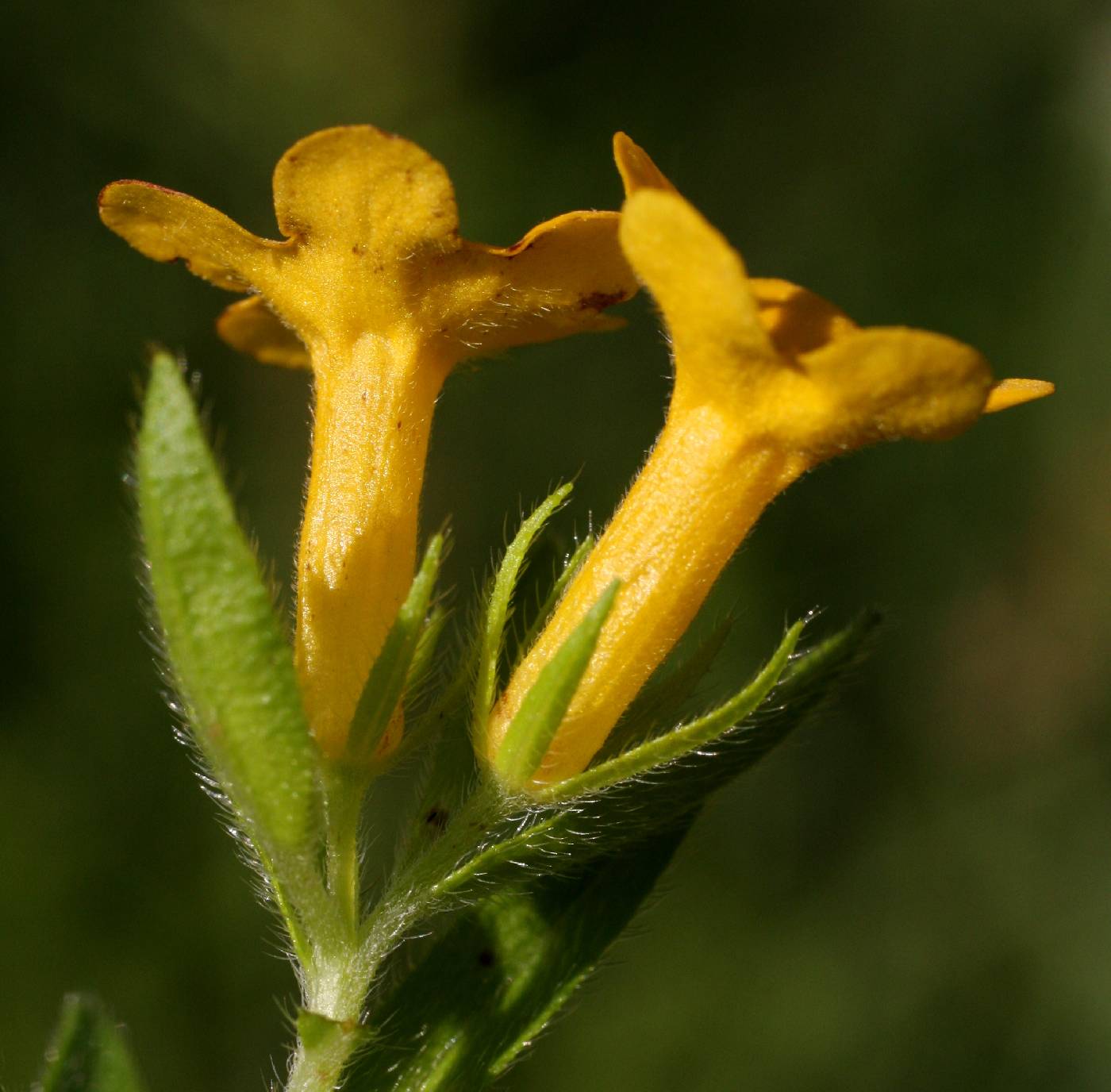Perennial herb 10 - 40 cm tall
Leaves: normally less than 25 below the inflorescence, alternate, stalkless, non-toothed, firm, without obvious lateral veins, 2 - 6 cm long, over 5 mm wide, lance-shaped to narrowly oblong, with narrowed but blunt tips, and densely covered with soft, somewhat appressed hairs. The lowest leaves are often reduced in size.
Inflorescence: one to three, terminal or subterminal, densely-flowered, leafy-bracted, compact, short-branched clusters with densely soft-hairy bracts below very short-stalked, deep yellow flowers.
Flowers: deep yellow-orange or light golden-yellow, 1 - 1.5 cm broad, funnel-shaped with 0.7 - 1 cm long narrow tube, and broad spreading lobes.
Sepals: five, much shorter than petal tube, 2.2 - 5 mm long (elongating to 7 mm in fruit), narrow, longer than wide, linear, and covered with fine, soft, appressed hairs.
Petals: five, but fused for over half their length into a 0.7 - 1 cm long, hairless (inside) tube, then separating into five, spreading, 0.5 - 0.6 cm long, fairly oval lobes with rounded tips.
Stamens: five, attached to inside of petal tube, but the oblong anthers not extending past the petal tube. Flowers on different plants can have the stamens attached at two different heights depending on the length of the style and position of the stigma: stamens attached low in the petal tube and below the stigma (long-styled) are called short; and stamens attached near the top of the petal tube and above the stigma (short-styled) are called long. Very rarely stamens of single flower attached at two different heights: two above the stigma, and three at same level as stigma.
Pistil: with one, deeply four-lobed, superior ovary; one, slender style; and one, distinctly two-lobed stigma. The styles of all flowers on a single plant can be either short or long (never mixed on a single plant), but neither type extends past the petal tube.
Fruit: a cluster of one to four, erect, shiny, creamy-white, hard, bony, smooth, non-pitted, 2 - 3 mm tall, egg-shaped nutlets with pointed tips, and rounded base with a central, constricted, collar-like rim. The nutlet clusters are subtended by the ascending, persistent, and elongated sepals.
Root: a stout taproot, which if broken or cut exudes a deep purple-red dye.
Stems: often several (up to five), erect, usually unbranched, soft-hairy with fine, silky, spreading hairs.
Similar species: Lithospermum canescens is most similar to L. caroliniense and its variety L. caroliniense var. croceum, but those taxa are more rough with stiff hairs, the hairs often have inflated bases, the sepals are longer (normally over 5 mm), the petals are a bit larger (lobes 7 - 9 mm long), and the nutlets are taller (over 3 mm). Also somewhat similar is L. incisum, but that species has appressed hairs on the stem, much narrower leaves (under 6 mm), longer petal tubes (over 2 cm), jagged-edged or toothed petal lobes, and pitted nutlets. Our other three species of Lithospermum have much smaller and less showy flowers with the sepals usually as long or almost as long as the petal tube, and two of those three species also have obvious lateral veins on their leaves.
Flowering: April to July
Habitat and ecology: Fairly common in prairie remnants and hill prairies.
Occurence in the Chicago region: native
Notes: In addition to having two different lengths of styles between plants (heterostyly), the character of stamen "length", or point of attachment in the petal tube relative to the stigma (end of style), has been examined quite a bit in this species (see Baker 1961). While most plants will have all five stamens inserted at the same height, either above the stigma in short-styled plants, or below the stigma in long-styled plants, there are some variant plants that have two stamens at one height and three at another. These rare variants had three stamens attached to the petal tube at the same level as the stigma, and two stamens attached above the stigma. There is some speculation this may be an attempt to promote cross-pollination or deter self-pollination, but further studies are needed.
Author: The Field Museum
Infrequent in dry, sandy prairie habitats, on dry, sandy knolls along roadsides and railroads, on the crests and slopes of open, wooded ridges in the area of the sandstone outcrops, and rarely in moist prairie habitats. Probably absent from many of the counties of the area of the Tipton Till Plain.
Stems from a stout taproot, often several (to ca 5), 1-4 dm at anthesis, usually simple; lvs lanceolate to narrowly oblong, 2-6 cm (or the lowest reduced), usually less than 25 below the infl, softly and densely canescent-strigose, obtuse; infl of 1-3 densely fld, terminal or subterminal, leafy-bracted cymes; fls heterostylic; cal-lobes linear, flat,
3-6 mm at anthesis, 6-8 mm at maturity, densely villous; cor orange to light golden-yellow, the tube 7-10 mm, the limb 1-1.5 cm wide; nutlets ochroleucous, smooth and shining; 2n=14. Prairies and dry, open woods; sw. Ont. to Sask., s. to Tenn. and Tex., and in the mts. from Pa. to Ga. and Ala. Apr., May. The Appalachian plants tend to have more spreading pubescence than those from farther west.
Gleason, Henry A. & Cronquist, Arthur J. 1991. Manual of vascular plants of northeastern United States and adjacent Canada. lxxv + 910 pp.
©The New York Botanical Garden. All rights reserved. Used by permission.














